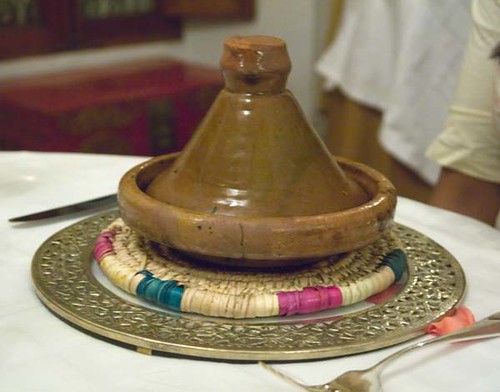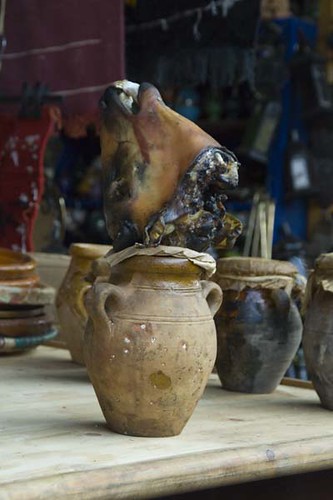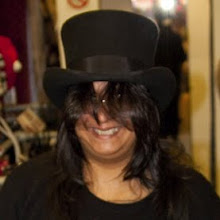We certainly ate well during our stay in Marrakech.
Read my reviews of Chez Chegrouni, Brasserie Orientale Le Tanjia, Café Arabe, Le Tobsil and Dar Moha.
Chez Chegrouni (inexpensive) is one of the grand dames of the Place Jemaa El Fna and, in common with the others, has dining on the ground floor as well as on two terraces overlooking the square. Popular with locals and tourists alike so arrive early whether it’s for lunch or dinner. Since the Place is definitely worth keeping an eye on it’s worth waiting for one of the tables with a view. The menu (in both French and English) features the standard selections of soups, tagines, couscous dishes and grilled meats and does include some vegetarian options. Order by writing down what you want on a paper napkin - this is taken away to the kitchen but will be returned to you as your bill at the end of your meal. Main dishes are between 30 and 50 dirhams. That price gets you a reasonable portion of tagine (well-flavoured and the long, slow cooking renders the meats tender too) but the grilled meat dishes are a little on the small side.
Brasserie Orientale Le Tanjia (mid-priced) was recommended to us by our hotel receptionist when the restaurant we wanted to book was already full. Located on Derb J’did (near the Bahia Palace) Le Tanjia is much more special on the inside than it’s exterior might suggest and don’t let it’s name fool you – it’s Moroccan, not Oriental, cuisine that it serves. The décor is sumptious Moroccan with a modern twist, the tables are well spaced out and the staff are welcoming, attentive and helpful. All our dishes were very good from the pigeon pastilla starter to the fish pastilla my mum had for her main to the lamb tagine I had for mine. Pete was a real fan of his honey chicken tagine which was right up his alley and worked very well. Most special of all was the restaurant’s special mechoui lamb (available for a minimum of two people only so my dad and sister shared) which was moist, tender and beautifully flavoured. Red wine drinkers were also keen on the Domaine de Sahari special reserve (which they’d been introduced to in back at the riad). All in all a lovely meal in beautiful surroundings. I’d have loved to have found time to return for lunch one day as the manager mentioned that it was usually served on their roof terrace but it leaves me something to look forward to next time.
Café Arabe (mid-priced) is a funky and casual café and restaurant based to the North West corner of the souks which themselves are north of the Place Jemaa El Fna. My guide book recommended it as one of very few options for a break within the souk area and Pete, my dad and I stopped for coffee during our walk from the tanneries back to the main square. We returned the next day for lunch with my sister and mum too and enjoyed our meal at an outdoor table in the lovely ground floor courtyard. The Café is deceptively spacious as the courtyard is flanked by two internal dining areas plus terraces on higher floors too. What’s different here is that the menu offers a mix of Moroccan and Italian dishes which can make a nice change after one too many tagines! The complimentary nibbles served were delicious and were generously refilled a couple of times. My dad and I enjoyed lamb chops crusted with mustard and breadcrumbs, down as roast lamb in the menu. Very nice. My sister had some grilled chicken skewers. Mum had another vegetarian tagine and Pete had an unusual tagine with meatballs in a tomatoey sauce and an egg broken into the dish and baked in situ. We all enjoyed the meals and I’d definitely recommend the Café Arabe not just for a pitstop if passing but as worthy of a special visit in itself.
Le Tobsil (expensive) is one of the very top restaurants in Marrakech and has a reputation to match. I found recommendations not only in my guidebook but on several online guide books and travel sites too. Oddly enough given the islamic nature of the country, Christmas day is a very busy one in Marrakech, full as it is of so many European travellers escaping another same-old same-old Christmas at home so it’s lucky that I had prebooked a table at Le Tobsil for dinner on Christmas Day evening about a week before leaving home. Our taxis dropped us off at an anonymous looking archway where we were met by a gentleman from the restaurant who led us through a maze of narrow alleys to the restaurant door in Derb Abdellah Ben Hessaien. A team of men wait in the archway to do just that and then return to the restaurant so they they can do the same on one’s departure! Greeted at the door by the owner Christine Rio we were shown to a table on the ground floor directly next to the gnawa musicians but were offered a choice between this one and another upstairs. We stuck with the ground floor and enjoyed being able to watch the musicians at close quarters – infact they even let my mum and I try one of their instruments. The décor of the restaurant was beautiful and luxurious and with rich fabrics, lovely lighting and rose petals strewn over the tables. A sprig of holly was added too. Our waiter explained that Le Tobsil offer a set menu only (which I already knew) and I confirmed the note I’d made on booking that one of our party was a partial vegetarian and ate fish or vegetables only. Not a problem. I hadn’t realised that aperitifs and wine were included, though we didn’t order any aperitifs, they did keep the wine flowing and wine drinkers said it was a pleasant one. First came a huge array of what I usually call meze dishes but which were introduced as a “salade marocaine”. These were all vegetarian and we were given some lovely bread to have with them. The first ones to come were all cold but soon after that a selection of hot options arrived, all but one also vegetarian. I sensibly limited myself to very little bread as the next course was a wonderfully flavoured chicken tagine. This was followed by a lamb tagine served with delicious vegetable couscous (and gravy). All very tasty. Next came dessert – wonderfully sweet and soft poached pears. Just when we thought we were all done we were given another dessert, a delicious orangey cake which none of us could manage more than a bite of two of. After tea (for those of us who had space) we gave them a number to call a taxi for us and one of their guides showed us back to the collection point where our taxi soon arrived. The set menu was priced at 600 dirhams per person but do note that this includes aperitif, wine, a true feast (where more of any course is offered to those who have the appetite) as well as tea and coffee. We felt it was good value.
Dar Moha (expensive) is another of the top restaurants in Marrakech, indeed many feel it’s Marrakech’s finest restaurant beating vaunted leaders such as Yacout. As such, it’s advisable to reserve a table in advance, especially on Fridays and Saturdays and during peak periods. In a city of beautifully restored riads, the setting too is more stunning than many others - once a royal palace and more lately the home of designer Pierre Balmain, dining tables are scattered throughout many interconnected rooms and those around the pool are most sought after during warmer months. The cuisine itself is innovative – traditional Moroccan dishes given a nouvelle twist by chef Mohamed who lived and worked for many years in Switzerland. As at Le Tobsil there is a set price for all diners but here diners are offered a choice for several of the courses and drinks are chosen from an a la carte wine and drinks list. The salade marocaine selection wowed me immediately. I couldn’t believe how much flavour the chef had packed into this array of tiny dishes such as sweet pumpkin puree, grilled aubergine slices wrapped around sticky dates, sweet shredded cucumber, red onion paste, a thick red pepper sauce and many more which I no longer recall. As well as all these cold dishes we were brought a selection of hot appetisers too such as little filo-pastry wrapped or breadcrumbed meat, fish, cheese and vegetables. After that fabulous start we moved on to the pastillas enjoying between us traditional pigeon, vegetarian (with a tomato sauce served alongside) and white fish versions between us. Having already enjoyed a couple of pastillas elsewhere we agreed that these were again a step above the competition. Most of us went for the beef fillet tagine, with one of us opting for the vegetarian one – they were served with two generous dishes of couscous and vegetables. All of us enjoyed our choices immensely. For dessert we enjoyed fancy apple and pastry concoctions called chakhchouka, subtle and refreshing fruit sorbets served in hand made biscuit boats and some freshly sliced and lightly marinated orange served with a mildly flavoured syrup. Service throughout was excellent and again we felt the experience was good value at around the same total price as Le Tobsil.
10 years ago






